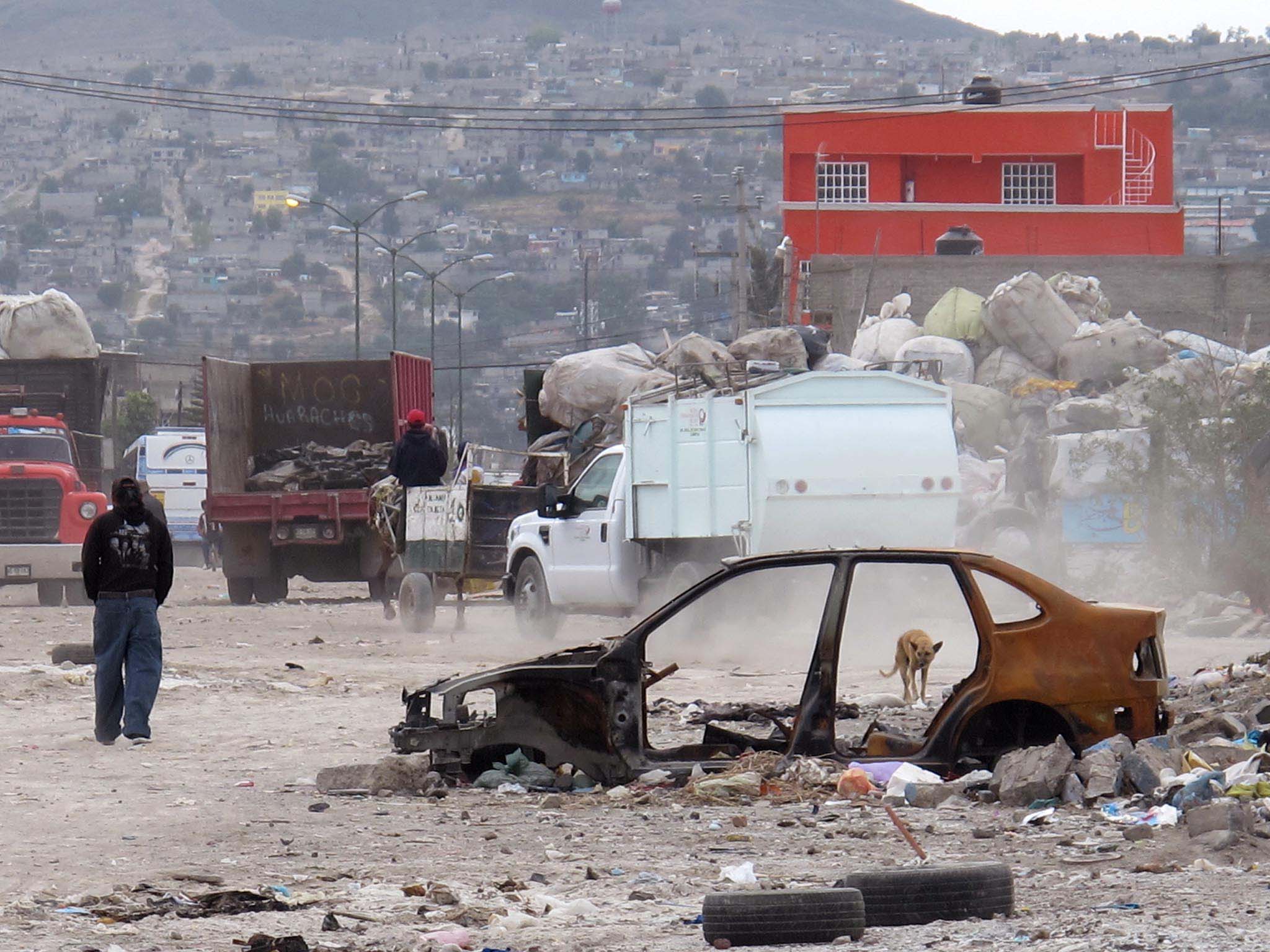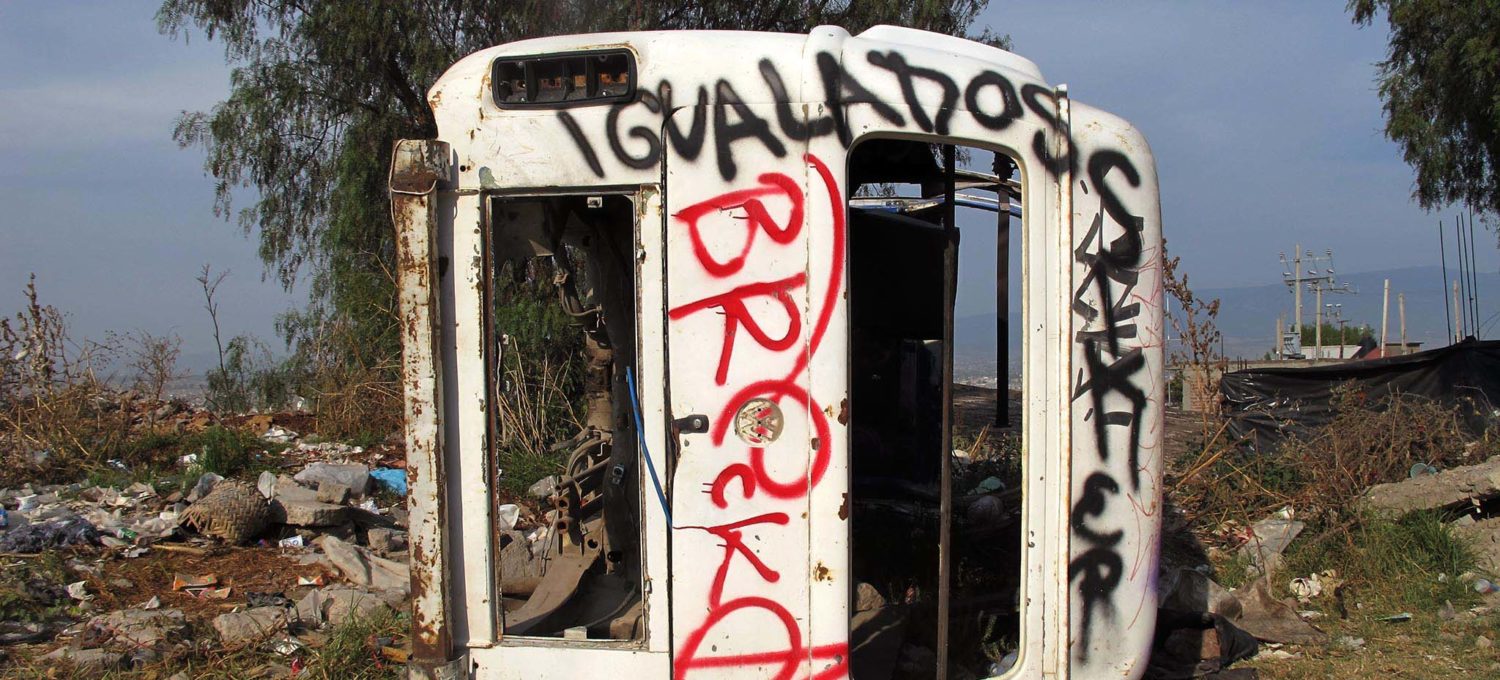The Chimalhuachi Volcano, encircled by the sprawling, poor, municipality Chimalhuacán and the Cerro del Pino now separated me from the Lake of Texcoco marking the eastern border of the city. I headed from the highway of Texcoco inwards through the dusty, struggling barrios built up into the heights of the hill. The streets had a quiet feeling. I felt watched.
Instead of heading toward the top of the hill I turned right and followed the slope downwards into the old center of Chimalhuacán, once a fishing village on the shore of the Lake of Texcoco. It still has a colonial church and large plaza with arches. Close to the main square I saw the painted facade of the offices of a political organization. I walked in. There I saw a man and a woman in their thirties sitting around a simple desk with some papers on it in a bare office.
They were the political representation of Mazahua Indians from the opposite side of the city in the State of Mexico. They were soliciting political support from the large community of Mazahuas who had migrated to Chimalhuacán from the western half of the State of Mexico. He said there were many indigenous people in Chicoaloapan with one colonia, Nueva Santa Cruz in particular, being practically all Mazahua from the State of Mexico. They generally didn’t acknowledge their indigenous identity to census takers so they were severely undercounted.
The bitter complaint of Juan Román, the junior in this partnership with a largely silent robustly built indigenous Clara Hernández, was the lack of political consciousness among the people. According to Román, plastic bags from high-end department stores are highly prized, and people reuse them to show where they have shopped. He shook his head at so much superficiality, the pathos of the frustrated consumer, who if he cannot have the product will hitch his or her identity to a plastic bag.
Politics here was based on the quid pro quo negotiation of services for votes and in a world of sacks of cement bricks, medical services, drainage and paving, ideology did not play a great role. Political organizing in these areas was exceedingly difficult because one was in a competition with all the other political organizations in the delivery of cement or some public service. One such organization was the powerful Antorcha Campesina.
Most of their support came for the plots of land they intermediated and bags of cement they brought. In the end all the leaders were corrupt, they would dine with the settlers on simple fare and afterwards dine again in good restaurants. Nonetheless the antorchista’s did have a highly ideological Maoist discourse. There are many leaders and many movements in the southeast of the city. And being a small fish in a big sea was evidently taking its toll on these organizers waiting, bored, in their empty office.
I left them to it and walked down the arches and had lunch at a large fish restaurant, which seemed to be a place for village notables. There it was not so hard to imagine that this was once a fishing village. After a thick fish soup with clams and crab I continued over the market and down the slope through the municipality’s commercial center toward the desolate, flatlands of the Lake of Texcoco. On the edge of the commercial district I struck upon a cultural center in a large, concrete building with a patio. I entered the courtyard and found it empty except for a small side-room where a thin greying man with long, thin bones, was teaching guitar to a girl.

The child left soon and I explained my project to the composer, Juan Herrera. I wondered what music was like here.
He told me that Chimalhuacán had an old musical tradition. The village, for example, has its own genre of carnival music based on waltzes from the court of the Mexican emperor Maximilian in the 1860s. For some reason the fishing village of Chimalhuacán was the primary source of servants for the emperor’s court. The fishermen came back to Chimalhuacán and made fun of the odd manners of their rulers, making dresses and suits based on courtly fashions. Now 150 years later the court is gone but the mocking waltzes still go on under the Chimalhuachi. Herrera told me I should understand that the musicians here were not artists, they were artisans. Their purpose was to accompany the dancers and when the lead dancer signalled they were to stop playing. They were not there to express themselves artistically.
Herrera is a composer of contemporary classical music. This was a great difference between the traditional conception of music and the modern western conception of a musician. He said practically all of the musicians learned only what they needed to know to play the music required for the event. Music in traditional Mexico is for the accompaniment of dances and so the musicians learn to play the accompaniment of these dances. Traditional Mexico is a people of artisans, who make things for other people, not artists who are expressing their relation to reality for the fulfillment of their own necessities.
He told me of one place where he was seeing a change in this. Santa Catarina del Monte, to the north, a village that provided municipal and military bands throughout the Valley of Mexico with musicians. They played romantic classical music but also had their own composers. They were indigenous Nahuatl, descendants of the Mexica of Netzahualcóyotl’s Texcoco kingdom. This highly traditional community had broken from the strictly artisanal conception of music. And their big village festivity for Santa Cecilia, patron saint of musicians, would be in 7 days. And though it wasn’t on my route, it wasn’t that far off it either.
I left the cultural center resolved to go to this village of musicians on the day of Santa Cecilia, even if it was little off the route. Surely it would bring good luck.
